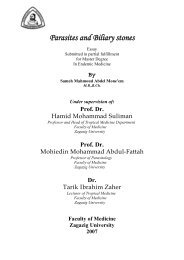Study of respiratory symptoms among sputum positive
Study of respiratory symptoms among sputum positive
Study of respiratory symptoms among sputum positive
You also want an ePaper? Increase the reach of your titles
YUMPU automatically turns print PDFs into web optimized ePapers that Google loves.
I I<br />
Interpersonal spread <strong>of</strong> tuberculosis may be enhanced in areas <strong>of</strong><br />
overcrowding, poor air circulation, or recirculated, unfiltered air. Rates <strong>of</strong><br />
tuberculosis infection in exposed contacts <strong>of</strong> individuals with active<br />
tuberculosis may also be dependent on the duration <strong>of</strong> exposure (Onorato<br />
and Ridzon 1995). In a study <strong>of</strong> a student with laryngeal tuberculosis,<br />
infection was noted as little as 5 hours <strong>of</strong>exposure (Braden, 1995).<br />
Pathogenesis <strong>of</strong> pulmonary tuberculosis<br />
The development <strong>of</strong> pulmonary tuberculosis from its onset to its<br />
various clinical manifestations is dependent upon a series <strong>of</strong>interactions or<br />
"battles" between the host and the bacillary invader (Lurie, 1964 and<br />
Dannenberg 1993).<br />
An inhaled unit <strong>of</strong> one to three bacilli is ingested by an alveolar<br />
macrophage. Either the bacillus is destroyed before any lesion is produced<br />
or it multiplies within the alveolar macrophage, which dies and reduces the<br />
amplified infection agent. Many <strong>of</strong> the bacilli are then ingested by and<br />
grow within monocyte\macrophage that have emigrated from the blood<br />
stream. The cells accumulate at the site, fanning a microscopic lesion.<br />
When the host becomes tuberculin <strong>positive</strong> a caseous center develops in<br />
this lesion. A lesion with a small caseous center (up to 2mm in diameter)<br />
may enlarge or may heal (or stabilize) before it is detectable by<br />
radiography (Dannenberg and Tomashefski. 1998).<br />
A larger caseous lesion may also heal or stabilize, or it may enlarge,<br />
shedding bacilli into the blood and lymph. Alternatively, a caseous lesion<br />
may liquefy and form a cavity (from which the bacilli enter the bronchial<br />
tree). In the liquefied caseum, the bacilli will grow extracellularly (for the<br />
first time), and from the cavity they spread to other parts <strong>of</strong>the lung and to<br />
24
















